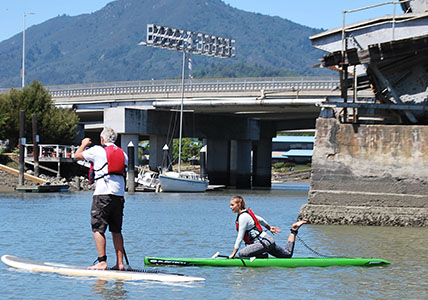In July, Bay Crossings took you to a stand-up paddleboarding class, where we learned the basics of this popular and relatively new recreational activity. When it comes to outdoor sports, stand-up paddleboarding has led the nation in growth with a 38 percent increase in participation from 2013 to 2014, according to the Outdoor Foundation's 2015 Outdoor Recreation Participation Topline Report.

According to the U.S. Coast Guard, a paddleboard is considered a “vessel,” so it’s important to understand certain boating responsibilities. Photo by Joel Williams
By BoatUS
Published: September, 2015
In July, Bay Crossings took you to a stand-up paddleboarding class, where we learned the basics of this popular and relatively new recreational activity. When it comes to outdoor sports, stand-up paddleboarding has led the nation in growth with a 38 percent increase in participation from 2013 to 2014, according to the Outdoor Foundation’s 2015 Outdoor Recreation Participation Topline Report.
But as these human-powered watercraft become more common in crowded harbors, busy waterfronts and other navigable waterways, sharing the water with both recreational boats and commercial vessels requires paddlers to make safety a priority. With so many people in the Bay Area owning both boats and paddlecraft, we offer these three easy-to-remember safety rules for stand-up paddlers.
When is a paddleboard a boat? According to the U.S. Coast Guard, a paddleboard is considered a “vessel,” so it’s important to understand certain boating responsibilities. Follow all local navigation rules and use common sense when paddling around other vessels that may not be as maneuverable or are restricted by their draft or size. Generally, a paddleboard is more easily able to turn and stop, whereas larger craft take time and distance to stop. Typically, it is safest to pass behind other vessels and let them cross in front of you. Try to avoid heavy boat traffic and pick a route away from congestion.
Practice defensive paddling: Defensive paddling means preventing collisions and mishaps in spite of the actions of others around you. Remember that boats may travel faster than you do and can carry a large wake. Some boats have awkward blind spots preventing good visibility at certain angles, so don’t assume a boater can always see you—especially at dawn or dusk. Wear bright colors and wear your life jacket with a whistle attached. Falling in or swimming in heavily trafficked areas can lead to the start of a bad chain of events. In narrow channels, stay as far right as possible and avoid crossing busy lanes. If you must, cross perpendicular to the lane so you get across quickly. If in a group, cross as a compact group—spreading out in a line like a bunch of baby ducks hinders traffic and increases the chance for a collision.
Don’t leave home without it: A life jacket is the minimum gear, but it only works if you wear it. If you’re concerned about comfort, take a look at high-tech, low-maintenance belt-pack inflatables or the newest vest designs that offer complete freedom of movement. Add a whistle—it will always beat yelling at the top of your lungs. Avoid paddling at night, but if you must, you’ll have to show a white light in sufficient time to avoid a collision. A flashlight or headlamp meets this requirement; a glow stick does not. And finally, a safety leash is most helpful in preventing an awkward and potentially dangerous separation from your board.
Golden Gate Ferry Service Announces Minor Anticipated Delays
Due to various construction projects and dredging in the Bay, Golden Gate ferries have recently experienced some service delays, with more delays expected in the coming weeks.
Golden Gate Transit is advising all ferry riders of potential minor delays through September, with delays expected to be between 10 and 15 minutes. In general, due to the nature of the work, it is not possible to predict exactly which trips may be impacted by delays.
“Golden Gate Ferry operations staff and vessel crews are working with the various contractors in an effort to minimize all unavoidable delays,” said Golden Gate Ferry Deputy General Manager Jim Swindler. “We apologize for the disruption and ask all our customers to plan for extra travel time as we improve our facilities.”
Golden Gate has issued a specific alert regarding travel at the San Francisco Ferry Terminal from September 11 to 14 and October 9 to 12. Delays may occur on Golden Gate ferries on these dates between 9 a.m. on Friday morning to 5 a.m. on Monday morning. During these times, work will be done on the inner and outer berths at the terminal in order to retrofit and replace the boarding ramp cylinders. This is part of a larger overhaul of the terminal that includes replacing the roofs, replacing the water and sewer lines, and repairing and repainting the walls. Passengers should be prepared for delays on all trips during these days.
For more information, contact Priya David Clemens at pclemens@goldengate.org.

